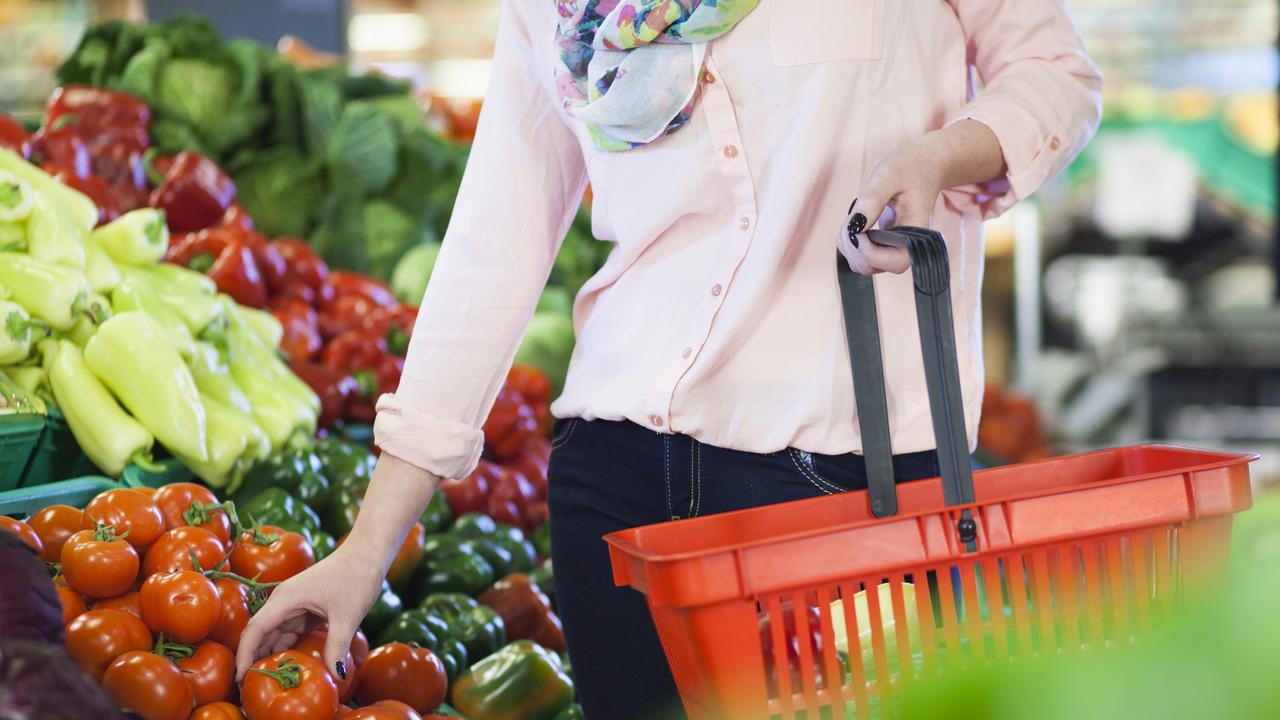How to get your kids to eat vegetables
Ex-MasterChef foodie-about-town Alice Zaslavsky has spent years delving into “the secret life of veg”, making it her mission to make cooking — and eating — vegetables in all their colourful glory cool again with her easy-to-replicate, flavour-first recipes.
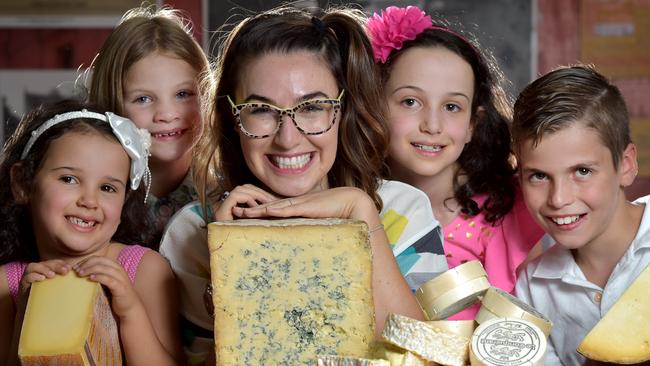
Food
Don't miss out on the headlines from Food. Followed categories will be added to My News.
Did you know it was treasonous to grow orange carrots in 16th century Netherlands? Or that rhubarb financed Catherine the Great’s expansion into Europe?
How about the fact that eggplant’s Italian name — melanzane — translates as “crazy apple” and reflects that Romans thought it caused all manner of ailments, including madness and melancholy, upon its introduction by Arab traders in the Middle Ages?
Food writer Alice Zaslavsky has spent years discovering and delving into “the secret life of veg” and has made it her mission to make cooking — and eating — vegetables in all their colourful glory cool.
Familiar to MasterChef fans as “Alice in Frames” for her love of quirky eyewear, Zaslavsky has turned an appearance on the hit cooking competition in 2012 into a growing career as a TV presenter, event MC, food writer and cookbook author.
But it’s her background as a teacher that most informs her crusade to use food as a tool for more than simply nutrition to get kids interested in cooking and food.
She says it’s the stories behind what we eat rather than pronouncements on “good” and “bad” food that will ultimately change the way we cook at home.
“I want to reshape some of the narratives we have around some of these veg. I don’t want it to be, eat your carrots because they’re healthy, because that’s not going to encourage people to eat them,” Zaslavsky says.
“Getting to know them a bit better, and the curiosities of these ingredients, might encourage some change. Also, it might create some conversations around the dinner table. I’m trying to offer parents a way to talk about vegetables (to their kids) beyond what they think they should say about them.”
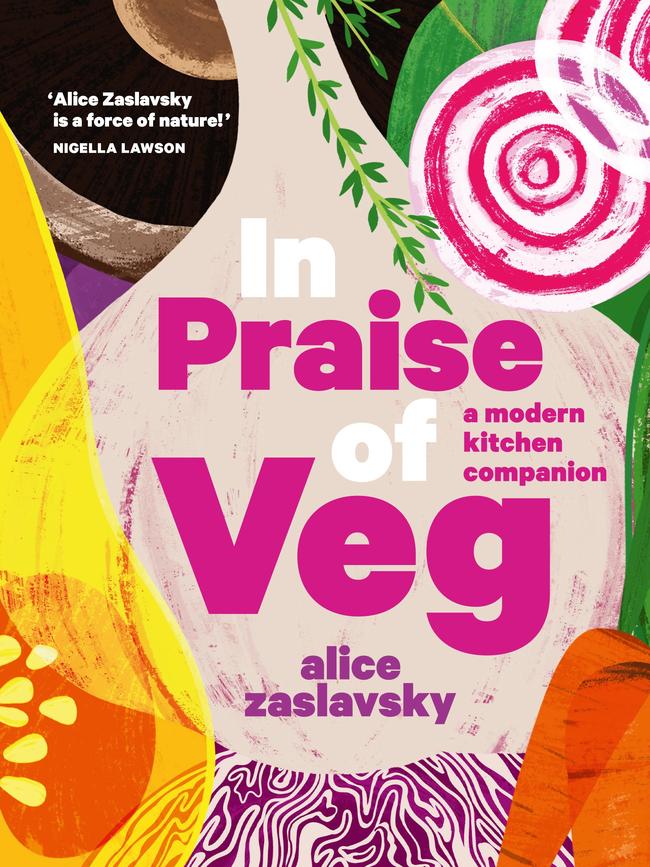

Zaslavsky, 35, this week released her second cookbook, a 500-odd page odyssey across the plant kingdom called In Praise of Veg. Billed as “the definitive guide to making vegetables the centre of the plate”, Zaslavsky profiles 50 vegetables, including favoured flavour combinations, how to buy and store and diverse cooking methods. It’s as densely packed with information and useful tips as it is weighty with easy-to-replicate flavour-first recipes.
Destined to sit alongside Stephanie Alexander’s A Cook’s Companion as a vibrantly colourful, veg-focused reference guide for accomplished and first-time cooks alike, it’s a joyous celebration of putting plants on the plate.
It’s no mean feat she wrote the tome in a matter of months last year while also juggling a newborn daughter.
“I didn’t let myself be afraid or nervous on how that was going to work, I just had to make it work. I’ve always been a good multitasker. I’m best when I’m busy,” she says.
Given “there’s such a myriad of information about vegetables on the internet” Zaslavsky had to approach the topic in a unique way. So, rather than an alphabetised compendium of ingredients, the vegetables are grouped according to colour.
She says this approach has enabled the book to be easily translated — it already has Dutch and German versions with a Spanish edition likely to follow — but also allows for a degree of discovery by readers.
“It’s an assumption we make that people know what (every) vegetable is. I’ve been to the supermarket and had my fennel scanned and the operator say, is this a …?’ (And I say) It’s a fennel and you can do this and this and this with it,” she says laughing. “For that person, they can go into the white bit (of the book) and work out what it is.
“What I’m trying to do with this book it to offer as many entry points to inspiration as possible. So at the very least, someone rethinks something they’re doing with beets, or even just thinks about beets. I don’t want (readers) to feel overwhelmed. That’s something I’ve been really conscious of when writing it. I didn’t want to write it for people who already cook. Or only for people who already love vegetables.”
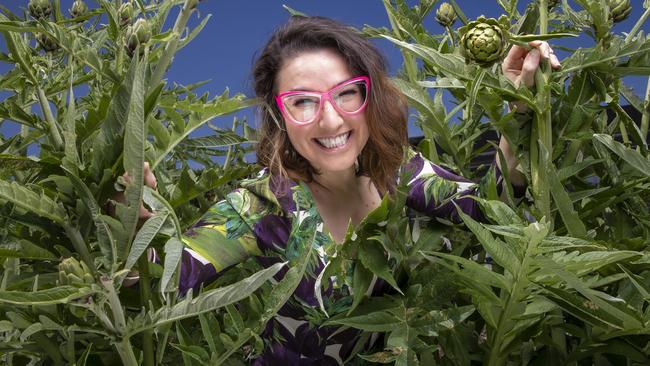
With increasing numbers of Australians looking to reduce the amount of meat they eat, the timing is right for a veg-focused cookbook. But this is one that doesn’t completely eschew the use of animal protein.
As she writes in the intro: “This is not a purely plant-based book, because that is not reflective of how my family — my husband Nick and our daughter Hazel (a.k.a The Nut) — and I eat. We are, however, plant forward in that we start with the veg and build dishes around them.”
While one in three Australians are committed to reducing their meat consumption, she says these tend to be Millennials or the younger Gen Z.
“But how do we move people of our parents’ generation, people who have grown up with meat and three veg. It’s entirely unrealistic to go from hot turkey to cold tofu in one book,” she says.
“How do we meet people where they are and how do we nudge it? It’s not just health, it’s not just environment, it’s not just humane treatment of animals or any or all of those things, it’s actually also taste. That’s the conversation we should be having — you can have a delicious, almost entirely veg meal, and then the meat or fish or cheese can be the garnish, the seasoning.”
The beauty of vegetables for the home cook, she says, is they encourage experimentation in the kitchen.
“I’m careful not to put labels on people and put too many barriers up. At its heart, that’s why I’ve written a book about vegetables, because vegetables are pretty simple to grow, even if you just have a little balcony or window sill, and the price point is much lower than if I was talking about free-range, pasture-raised chicken.
“If you burn a carrot — actually it’s probably going to taste better — but it’s also not going to break the bank.”
Thriftiness informs Zaslavsky as a cook, and while a zero-waste ethos today is as on-trend as it gets, her whole-of-veg approach stems instead from a childhood growing up in Soviet-era Georgia.
Immigrating to Australia just after the fall of the Iron Curtain as a six-year-old, Zaslavsky says recent pandemic panic buying in our supermarkets brought up memories and emotions from that time. “The empty shelves, I found it really challenging. It triggered something in me that I didn’t realise was latently there,” she says. “The notion that it could all be gone at any moment.”
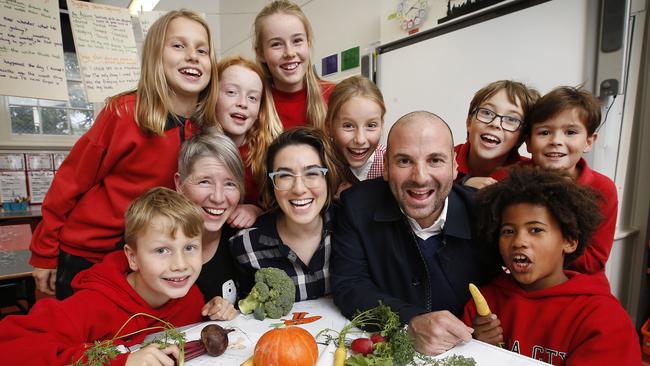
She says Australia was a “massive culture shock” when the family arrived in the early 1990s. “We went from ration tickets and eating what we grew on grandpa’s dacha, to massive supermarkets and shelves full of abundance,” she says. “All of that has informed my sense of thinking about food as high — low. I’m happy to play with the bruised veg at the side of the shop, which I very much remember, as well as relishing and revelling in the bougie (bourgeois) stuff. (The) feasting and fasting of food, I’m all about that.”
She says during Melbourne’s two lockdowns she began to rely on skills “I didn’t realise I had absorbed by osmosis from mum”.
“Nothing goes to waste in mum’s kitchen. From the water she boils the corn in to the fat in the bottom of a pan, everything has a place, because it’s all flavour. I find myself using every part of a veg, popping it into the freezer. Just thinking, how can I use this so it doesn’t go to waste?”
Zaslavsky might’ve learnt cooking passively helping her mum in the kitchen, but it was a much more hand’s-on approach she took with her students at Haileybury College, where she was deputy head of humanities.
“I fell into teaching, but I felt like I belonged in teaching, and still do,” she says. “I stepped into the classroom and the lights turned on. It was my stage, my students, I could see how engaged they were.”
And it was through food, she found, that students responded to her lessons best. “I found that food was a really great way to engage them in history and geography and English; teaching numeracy and literacy through food.”
Appearing on MasterChef was a “right place, right time” happy accident for Zaslavsky. She had been taking a course at William Angliss catering college to help in her creation of a food and culture subject for the school when the MasterChef crew arrived to film the auditions.
“They were looking for people with personality who could cook. I hadn’t thought of (MasterChef) as a trajectory for my life at all.”
A dynamic and bubbly personality on screen, Zaslavsky, who finished seventh in the fourth season, went on to host kids cooking shows Kitchen Whiz and Crunch Time and write a kids’ cookbook, Alice’s Food A to Z. But it was Phenomenom — an educative series aimed at kids in grades 3 to 6 that comes complete with curriculum guide and teaching plan — that was the culmination of her experiences from classroom to kitchen.
“Food literacy doesn’t end when you learn your times tables at school, it’s a lifelong conversation. I’m still learning, and getting more food literate,” she says. “I don’t want to be the expert, I want people to feel like Alice is learning along with me. And that’s good. I think a lot of the time food writers write for each other, to impress each other. I think it’s time to let go of (that) if we want people to get better at cooking and eating.”
SPRING ONION QUICHE
Serves 12
INGREDIENTS
15 spring onions
50g butter
125g speck, chopped into 1cm pieces
200ml thick (double) cream
8 eggs
3 tablespoons roughly chopped dill, plus extra to serve
½ tsp ground nutmeg (or a few good scrapes of fresh nutmeg)
100g gruyere (or cheddar), grated chopped baby parsley, to garnish (optional)
Shortcrust pastry
1⅔ cups (250g) plain (all-purpose) flour, plus extra for dusting
100g cold salted butter, chopped
½ teaspoon salt flakes
½ teaspoon ground white pepper
1 egg yolk
1 tablespoon apple cider vinegar

METHOD
To make the pastry, place the flour, butter, salt and pepper in a food processor and blitz to breadcrumb consistency. Add the egg yolk and vinegar and pulse until the dough forms a ball, adding water 1 teaspoon at a time if needed to bring it together. Shape into a disc and cover with plastic wrap. Chill for 1 hour, or overnight.
Preheat the oven to 220C. Line the base of a 5 cup (1.25 litre) baking dish with baking paper.
On a lightly floured work surface, roll out the pastry to a 5mm (¼ inch) thickness. Use the pastry to line your baking dish, patting it into the sides of the dish, leaving the overhang. Chill for 15 minutes. Dock the base with a fork (in other words, just ‘poke’ it) and trim the overhang.
Pop a sheet of baking paper on top of the pastry, fill the dish with baking weights (or dried rice or beans) and blind-bake for 20 minutes. Remove the baking paper and weights, then bake for a further 10 minutes, or until golden and crisp.
Meanwhile, finely slice the white ends of the spring onions, chop the green stems into 1 cm pieces, and reserve the tops, leaving them whole. Melt the butter in a frying pan and saute the white spring onion bits with the speck over medium heat for 3–4 minutes. Transfer to a bowl and chill slightly.
Add the cream, eggs, dill, nutmeg, cheese and green spring onion stems to the speck mixture and whisk to combine. Season with sea salt and freshly ground black pepper. Pour the mixture into the pastry shell.
Turn the oven temperature down to 150C. Bake the quiche for 40 minutes, or until the egg has set. Thinly slice the remaining spring onion and sprinkle over the baked quiche, along with the parsley, if using, and the extra dill. Serve warm.
JALAPEÑO BUSINESS
Makes 12 poppers
INGREDIENTS
12 jalapeño chillies
200g cream cheese
½ teaspoon smoked paprika (plus extra for sprinkling)
½ teaspoon garlic powder
1 tablespoon coriander (cilantro) stems, finely chopped (you can use the leaves for garnishing, if you like)
¼ teaspoon salt, plus extra for sprinkling
100g cheddar, grated

METHOD
Preheat the oven to 200C. Line a baking tray with baking paper.
Hold your chillies by the stems and use a small serrated knife to make a slit in the top, like a suspicious squinty eye. Using the knife or a teaspoon, scoop out the membrane and seeds. Give the chillies a tap and a rinse to get rid of any sneaky seeds.
Put the cream cheese, paprika, garlic powder, coriander stems and salt in a bowl and mix together with a fork, smushing to combine.
Use a teaspoon to press the mixture into each popper, leaving an indent for the cheddar.
Fill the indent with cheddar (you knew this one was coming). Pop the poppers (ha!) onto the baking tray and bake for 13–15 minutes, or until the cheese is bubbly. If you’d like a little extra burnish, give them a quick blast under the oven’s grill setting.
Sprinkle with a smattering of paprika and serve.
TIPS This recipe works with both red and green jalapeños, as they’re actually the same chilli, although the green ones do hold their shape slightly better as they are firmer, being less ripe.
Keeping the cheddar separate from the cream cheese helps save the filling from bubbling over, but you can mix it all together if you’re pressed for popper-prepping time
READ MORE:
HOW TO SECURE A BOOKING AT A BUSY RESTAURANT
EX-MASTERCHEF CONTESTANT TO HOST POPULAR COOKING SHOW
Originally published as How to get your kids to eat vegetables



